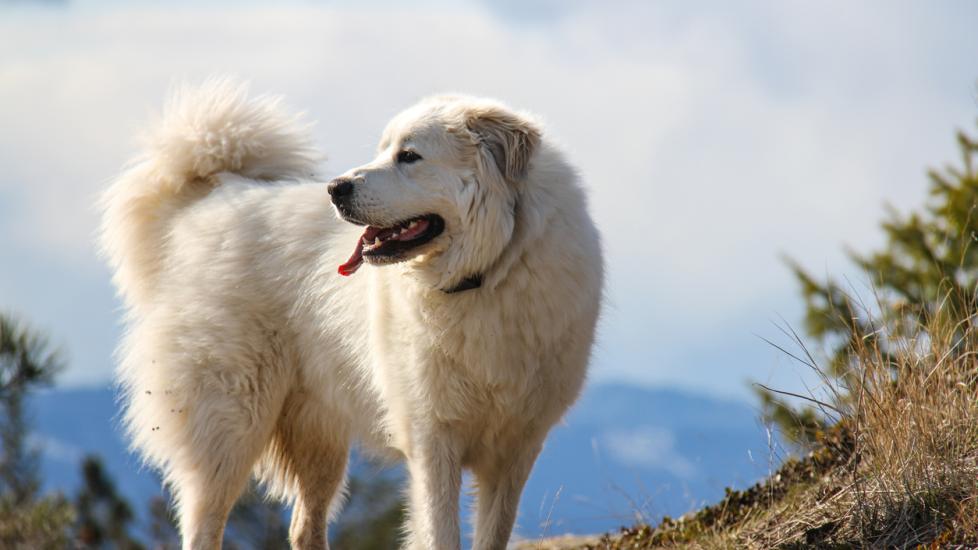Great Pyrenees
iStock/creativex
The majestic Great Pyrenees is a giant dog breed first bred for guarding livestock. Originally from the Pyrenees Mountains between Spain and France, the breed’s characteristic thick white coat makes for perfect camouflage in the snowy landscapes where they would protect sheep from predators such as bears and wolves, according to the Great Pyrenees Club of America (GPCA).
Because they guarded livestock from large predators, the Great Pyrenees size is impressive. This breed stands 25–32 inches at the shoulder, and the average Great Pyrenees’ weight is 85 pounds for females and over 100 pounds for males.
Though they’re incredibly strong and fast dogs, at home Great Pyrenees are usually gentle and calm dogs around the people they love. They can make excellent family pets.
Caring for a Great Pyrenees
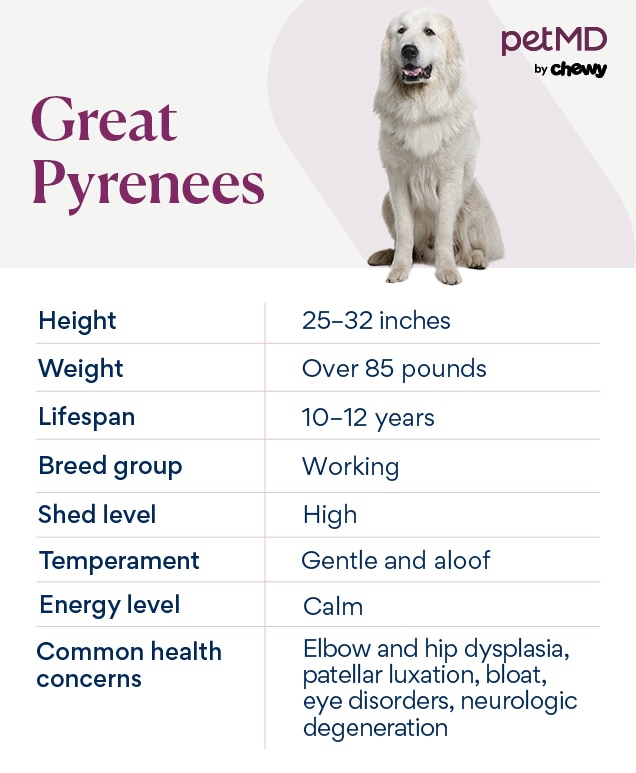
While excellent guardians, Great Pyrenees dogs aren’t overly active—after all, they need to conserve their energy for any threats to their flock. They were also bred for their independence, allowing them to be left in mountain valleys alone to guard their sheep.
This means that in home life, Great Pyrenees don’t require a highly active lifestyle and are often low-energy dogs. They value their alone time, which can make them more strong-willed during training.
Their grooming needs are not excessive (despite their abundant fur) because their long outer coat is dirt- and tangle-resistant. However, weekly brushing helps maintain their soft undercoat and minimize shedding in the home.
Great Pyrenees Health Issues
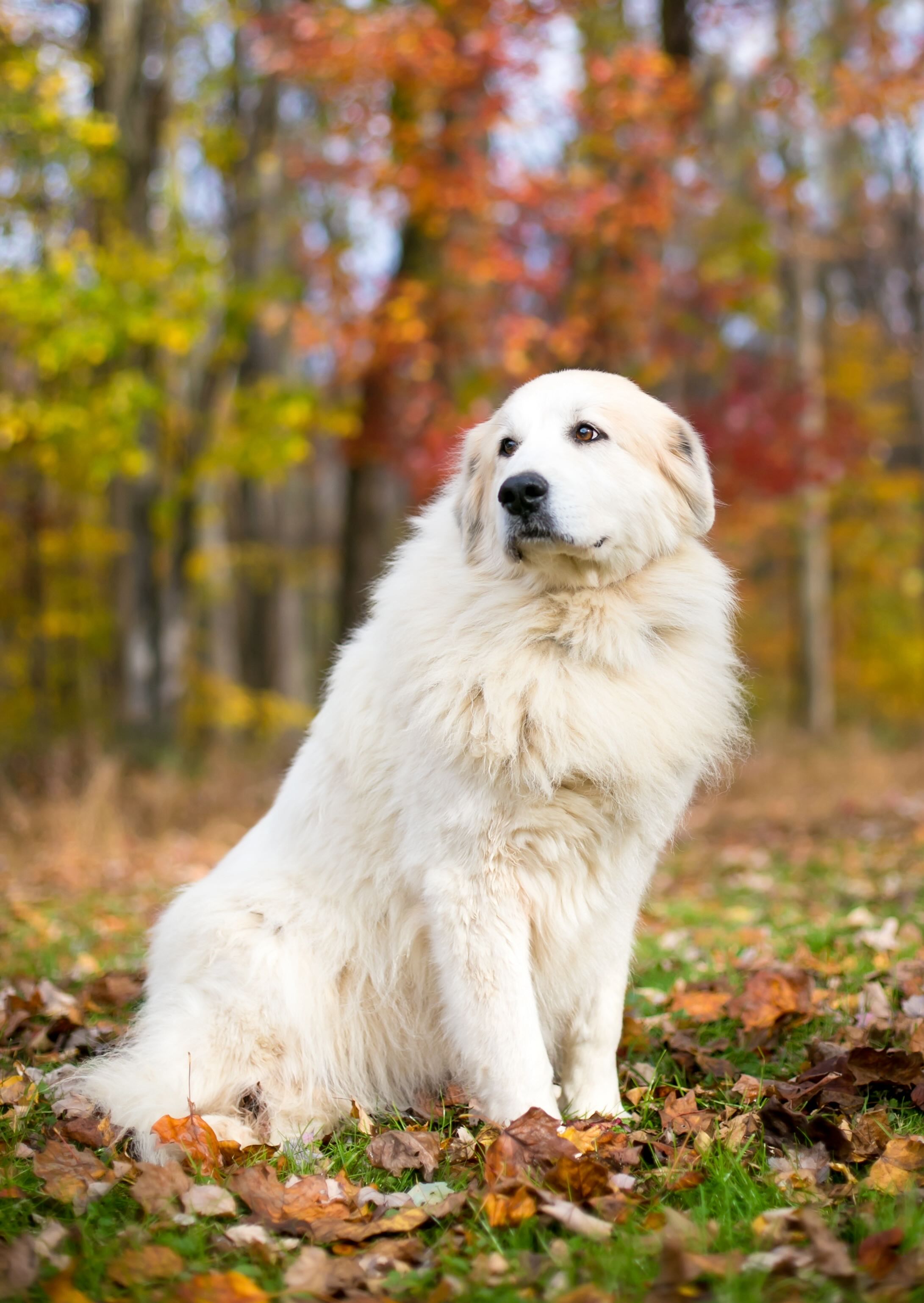
The typical Great Pyrenees lifespan is 10–12 years, which is a little longer than the average life expectancy for giant dogs. They’re generally very healthy dogs, but reputable breeders should screen for a handful of health conditions the dogs can develop.
Growth Disorders
Elbow dysplasia and hip dysplasia are terms used to describe when the bones of the elbow or hip joints, respectively, do not align appropriately when developing. This causes rubbing and grinding of the bones that cause the joint to deteriorate and lose function.
Elbow dysplasia and hip dysplasia can be hereditary conditions that affect Great Pyrenees dogs, but they can also be affected by exercise habits, weight, and nutrition.
Great Pyrenees should also be screened for chondrodysplasia (dwarfism), an inherited growth disorder seen in this breed that causes shortening of the limbs, trunk, and muzzle.
All of these conditions can be screened with X-rays, and treatment varies depending on the severity.
Patellar Luxation
Great Pyrenees can develop luxating patellas, an inherited condition where one or both of the kneecaps dislocates, popping in and out of place. Although patellar luxation is not generally considered a painful condition, it may cause the dog to favor one leg and predisposes them to other knee injuries and arthritis.
Depending on the severity of the patellar luxation, surgery may be recommended to prevent further injury and improve the dog’s quality of life.
Eye Disorders
Great Pyrenees dogs can be predisposed to a few eye disorders, such as:
-
Entropion: when the eyelid grows inward, causing the eyelashes to rub against the surface of the eye
-
Cataracts: clouding of the lens of the eye, which causes vision impairment
-
Canine multifocal retinopathy (CMR): an inherited disease of the eye that can lead to blindness
In most cases of entropion and cataracts, veterinarians can diagnose and treat the dog through surgery. CMR, however, does not currently have any treatment, but it can be screened for with certain dog DNA tests.
Neuronal Degeneration
Neuronal degeneration (NDG) is an inherited disease that causes degenerative changes to the entire nervous system, including the brain, spinal cord, and peripheral nerves.
Clinical signs typically begin when Great Pyrenees puppies are less than 1 year old and may be mild, such as stumbling or dragging a paw. But the condition will progress until the dog is no longer able to stand or walk on their own.
There is no current treatment for NDG, but it can be screened for with genetic testing.
Gastric Dilatation and Volvulus
Gastric dilatation and volvulus (GDV) is a severe form of bloat in dogs that can affect any deep-chested breed, including the Great Pyrenees.
Bloat typically happens when a large amount of food and gas builds up in the stomach. The increased pressure from the gas builds up, causing the stomach to expand and, in cases of GDV, twist and cut off blood flow to important organs (the stomach and spleen).
Many deep-chested dogs undergo a gastropexy surgery (in which the stomach is tacked to the abdominal wall or the diaphragm) to help prevent GDV, often when they are spayed or neutered.
GDV can be a life-threatening condition. Seek immediate veterinary care if you notice any of these signs:
-
Distended abdomen
-
Retching without producing any vomit
-
General signs of abdominal pain, such as standing and stretching
What To Feed a Great Pyrenees
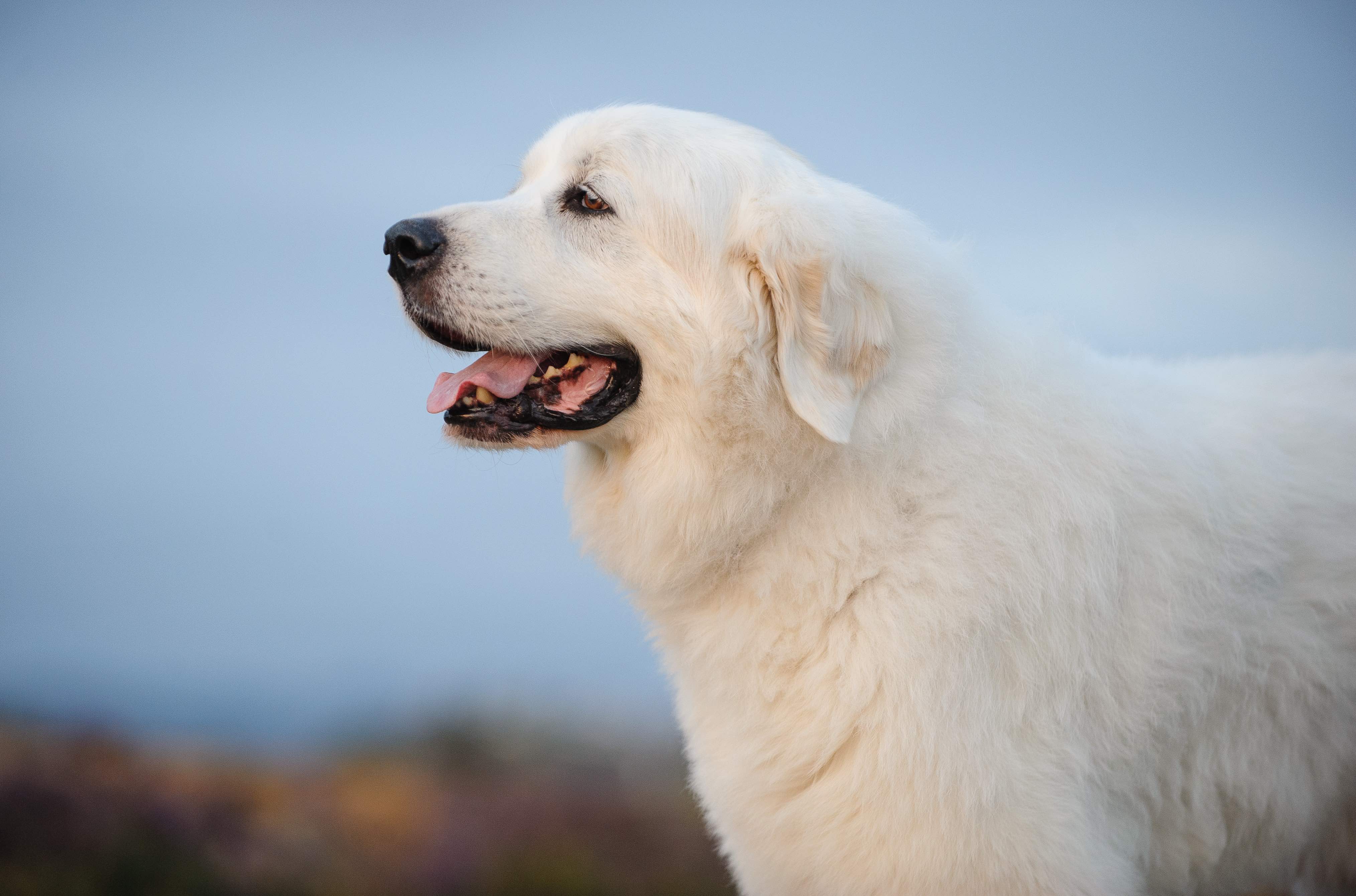
Choosing the best dog food for a Great Pyrenees comes down to the needs of the individual dog.
While it’s always important to select a diet with high-quality ingredients that meets standards set by the Association of American Feed Control Officials (AAFCO), it’s best to discuss diet with your dog’s veterinarian. A vet can make recommendations based on your pup’s specific medical history and lifestyle.
In general, Great Pyrenees do well on a dog food designed for large breeds. Make sure to choose a good that’s appropriate for your dog’s current life stage (puppy, adult, or senior).
How To Feed a Great Pyrenees
Great Pyrenees are deep-chested dogs susceptible to bloat and GDV. To prevent this serious condition, it’s best to take precautions when feeding your dog:
-
Talk to your vet about a gastropexy procedure for your dog
-
Feed your Great Pyrenees dog multiple small meals (two or three) throughout the day, instead of one large meal
-
Avoid vigorous exercise around mealtimes
-
Avoid raised food bowls
-
Use a slow-feeder food bowl to slow your dog down as they eat
How Much Should You Feed a Great Pyrenees?
Before bringing home a Great Pyrenees puppy, consider your budget. An adult Great Pyrenees’ weight can range from 85–100 pounds for females and over 100 pounds for males, which means the amount of food they need is going to be much greater—and much more expensive—than feeding a smaller dog.
There’s no overall recommendation for how much to feed your dog, as this depends on an individual’s health, lifestyle, and weight. Follow the label on your dog food packaging for guidance and talk to your veterinarian for specifics.
Nutritional Tips for Great Pyrenees
For Great Pyrenees that have growth disorders affecting their joints, it’s beneficial to give them joint supplements with glucosamine and chondroitin to help keep their joints healthy. Omega-3 supplements, such as fish oil, also aid in protecting joint health as well as keeping their skin and coat healthy.
Always talk to your veterinarian before giving your dog a supplement.
Behavior and Training Tips for Great Pyrenees
Great Pyrenees Personality and Temperament
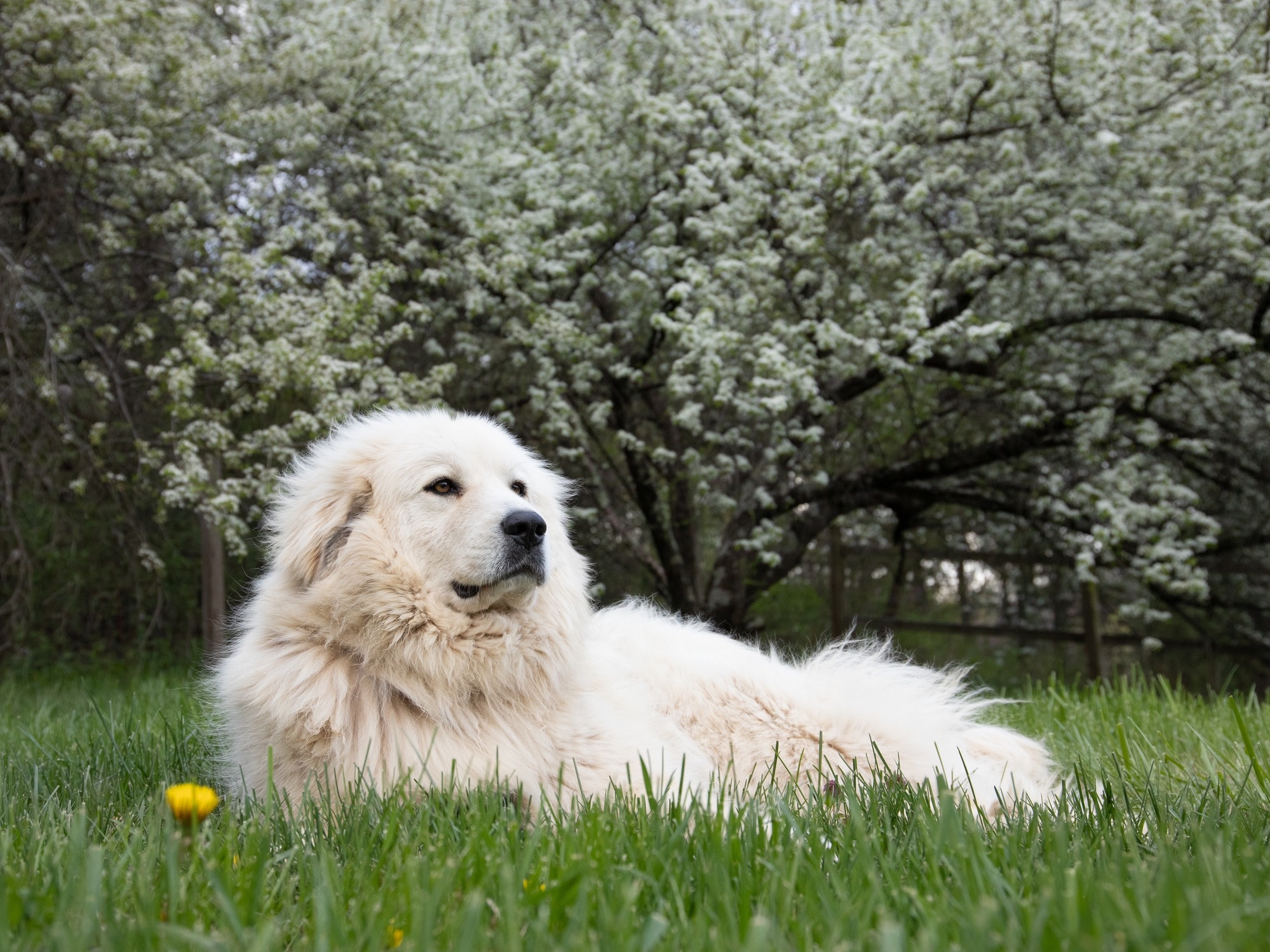
Every dog is an individual with their own personality, but the typical Great Pyrenees temperament is calm, independent, and alert, according to the GPCA. Their gentle demeanor makes them suitable in families with children who understand how to interact with dogs, but Great Pyrenees may be best in homes without smaller children who may be easily harmed by an accidental bump from a 100-pound dog.
Great Pyrenees Behavior
They aren’t highly active dogs, but Great Pyrenees do enjoy roaming outside. It’s important to keep your dog within an area enclosed by a sturdy fence to prevent them from roaming too far and becoming lost.
Great Pyrenees dogs don’t have a strong drive for chasing, but they are known to bark to alert their family—even if it’s just because they spotted the mail carrier.
Great Pyrenees live well with other pets but value their alone time. They may need a space where they can retreat for time away from other, more playful companions.
Great Pyrenees Training
Great Pyrenees were originally bred to be independent flock guardians, and that independent personality has persisted over time. Their need for independence may make training challenging. The breed club recommends that first-time pet parents enroll their Great Pyrenees in obedience classes for training assistance.
As with all dog breeds, consistency and positive reinforcement produces the best training outcomes. Early socialization of Great Pyrenees puppies to as many different people, places, and animals is also critical so they learn to be well-mannered and comfortable in new situations.
Great Pyrenees were originally bred to be independent flock guardians, and that independent personality has persisted over time.
Fun Activities for Great Pyrenees
-
Cart- and sled-pulling
- Working on farms
Great Pyrenees Grooming Guide
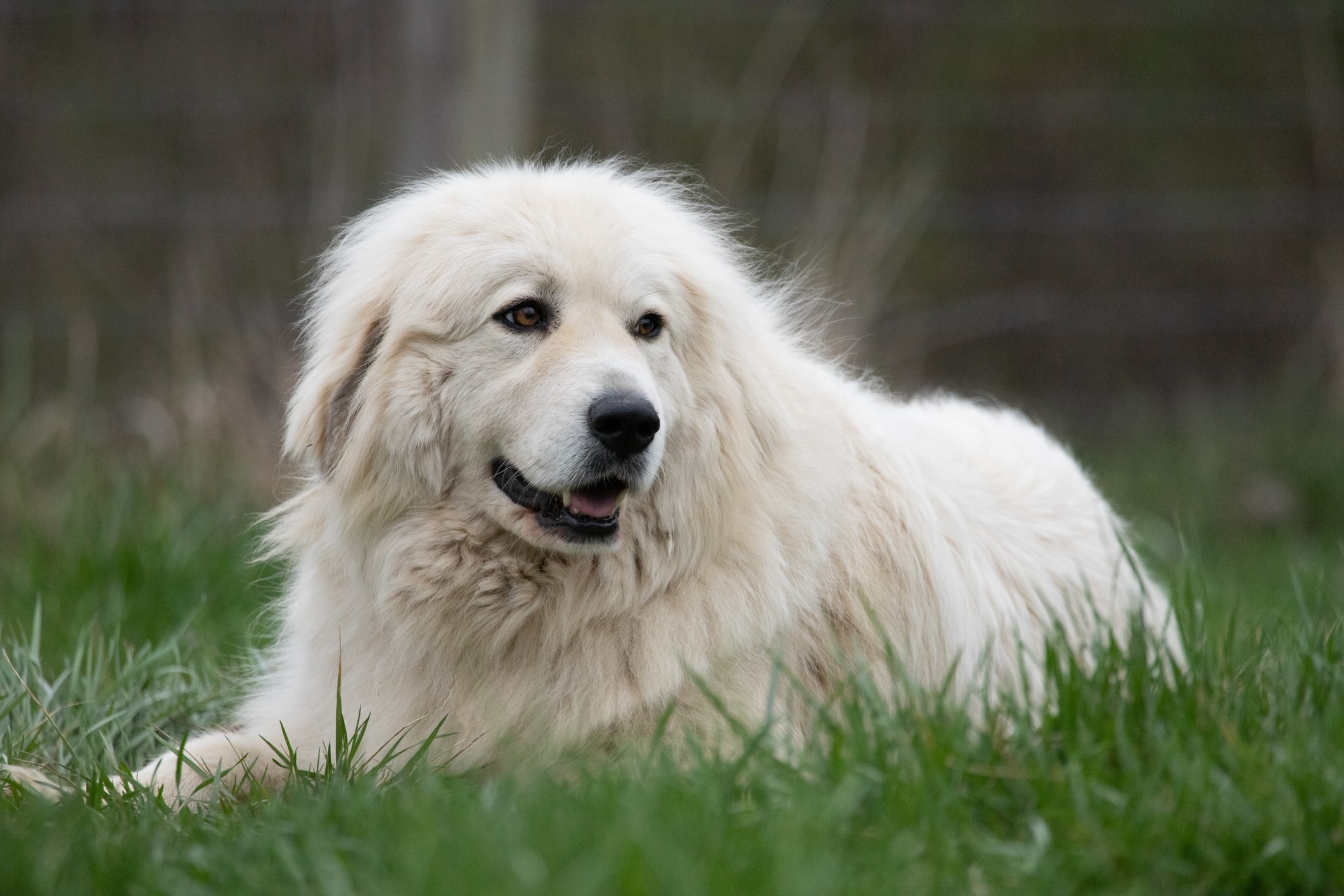
Great Pyrenees are known for their majestic white coat that has a long outer coat and soft undercoat. The silky outer fur tends to be resistant to tangles and dirt, which lessens the grooming requirements for this breed.
That said, Great Pyrenees are heavy shedders, and more frequent grooming can help pet parents stay on top of the flying fur.
Skin Care
Skin care for the Great Pyrenees can vary depending on the individual’s needs. However, the breed does not typically have sensitive skin. Contact your veterinarian if you notice any changes in your dog's skin, such as redness or if your dog is frequently scratching.
It’s important to keep your dog on a flea and tick preventative year-round, especially because Great Pyrenees love being outside.
Coat Care
Because their outer coat is smooth, weekly brushing should be sufficient to keep the coat in good condition. This will also help reduce shedding. The GPCA says a 30-minute brushing session is enough to keep your dog’s coat in good condition.
Eye Care
While Great Pyrenees are not typically prone to tear stains, some dogs might require special care or routine cleaning to prevent eye infections. Make a vet appointment if you notice changes in your dog’s eyes, such as abnormal discharge, redness, or cloudiness.
Ear Care
Routine ear cleaning with a veterinary-approved ear cleanser is important to maintain healthy ear canals in your Great Pyrenees and prevent ear infections. This should also be done any time a Pyrenees is in water, such as after swimming or bathing.
Considerations for Pet Parents
Though they got their start in the mountains, the calm lifestyle of the Great Pyrenees makes them good companions in an urban household. They are gentle and affectionate toward their family, but early socialization is key to help them be their best self.
Great Pyrenees are not often found excelling in obedience championships because of their desire for independent thinking. But with patience and routine, they can be very well-mannered and trustworthy companions. And, of course, they excel as livestock guardians and can thrive in homes where they are able to roam with farm animals.
Great Pyrenees FAQs
How tall is a Great Pyrenees on all fours?
A Great Pyrenees, full-grown, stands 28–31 inches tall at the shoulder. The dogs weigh 85–110 pounds or more.
How long do Great Pyrenees live?
The average Great Pyrenees lifespan is 10–12 years.
Do Great Pyrenees shed?
Yes, Great Pyrenees are heavy shedders year-round. Brushing can help reduce shedding levels.
Is a Great Pyrenees a good family dog?
Yes, Great Pyrenees are good family dogs. Their calm temperament is suitable for homes with children who understand how to appropriately interact with dogs. That said, because they’re so big, small children might accidentally be bumped and knocked over.
What’s the difference between a Great Pyrenees vs. a Pyrenean Mastiff?
Great Pyrenees and Pyrenean Mastiffs are closely related and share many similarities in appearance, function, and personalities, as both were bred to protect livestock in the Pyrenees Mountains. However, Pyrenean Mastiffs are typically larger, have more color in their coats, and are inclined to bark more than Great Pyrenees dogs.
